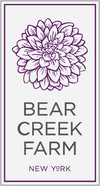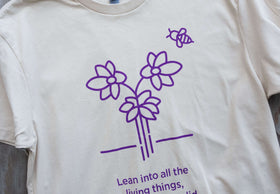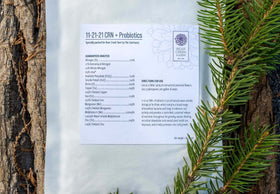Tulips are a revelation, and at Bear Creek Farm we see part of our role as shining a light on the more exotic double tulips. These varieties tend to bloom later then the traditional tulip (called a single tulip, often associated with Easter or Passover). Tulips are quite aesthetically varied and are far more interesting to play with than people might expect. Tulips are not fully represented by the standard yellow bouquets found in supermarkets. In fact, there are many variations in length, petal shape, fragrance, bloom time, fringes, and ruffling. (Some tulips may even resemble small peonies.)
When planning tulip beds, remember the following key points:
General Tulip Tips
Tulips need sun. Plant tulips in an area that will be bathed in sunlight.
Tulips need good drainage. Plant tulips in an area where they won’t be waterlogged by snowmelt, or by drenching spring rains where the water will sit without proper runoff.
Tulips need about 12 weeks of cold weather to flower properly. If you are someone who hates very cold weather, take comfort in a silver lining - your tulips thrive in cold temperatures. This means planting time is forgiving. Plant most anytime in the fall once temperatures cool as long as there is 3 months of cold weather in the new year before spring. (Note, however, that if you live somewhere where temperatures don’t generally freeze for long, you can still plant tulips by purchasing pre-chilled bulbs.)
Bulb Planters are unnecessary. In our opinion, a bulb planter has always seemed a fussy tool. As a practical matter, it is just as easy to plant by hand. (Remember that tulips look nicer when grouped in parties at least seven.) Also, getting your hands dirty gives gardeners an excuse to really inhale the scent of that yummy soil.

Digging In: How to Plant Your Tulips:
- Dig a patch about 6-8” deep and large enough to accommodate bulbs spaced ½” – 1” apart.
- Loosen the soil at the base to promote thorough root development.
- While the rule of thumb is to plant bulbs pointed side up, there is really no need to be overly literal. If bulbs shift while watering, there is no need to worry.
KEY POINT: WATER FOR YOUR TULIPS
- Drench your tulips once placed. Do not hold back. Really soak them through and through. You can even fill the trench halfway with water.
- This is the secret to creating the strong roots that leads to longer stems and bigger blooms.
- Backfill the hole and water again.
- You don't need to fertilize the bulbs unless you have done a soil test and found some nutrition deficiencies.
- If you do fertilize make sure to do so after backfilling. Sprinkle the fertilizer on top. Although it may seem counterintuitive, do not put the fertilizer in the planting hole. Instead, sprinkle it on the uppermost layer as this mitigates the possibility of root burn - and maximizes the abundance of your coming spring tulip blooms.
PRO TIP (OPTIONAL)
For true tulip aficionados: we follow the process described above at Bear Creek Farm; however, we plant tulips in raised beds. During harvest, we pull up the entire plant - bulb and all from the soil because this provides maximum stem length, extended storage, and a long vase life. We have found that our native soil is too rocky and harsh to be able to pull out the bulbs without damaging the flowers, which is why we use raised beds. With the bulbs attached, tulips can be stored dry for weeks in the cooler, because they are still connected to their food source. When it’s time to use them, we simply cut off the bulbs and place stems into water. If you have the room, capacity, and motivation to experiment, it is fun to play in this manner. However, if raised beds aren’t for you, your blooms will be gorgeous, nevertheless.

Know Before You Grow
- Tulips sometimes to tend to bend and curve after harvest.
- Wrapping the top 2/3 in a funnel of paper can help.
- Once fully hydrated, they will stand straight, and stems tend to elongate during the first few days.
Now that you've finished reading this article, you should check out our tulip planting primer, dahlia growing guide, and cutting guide for dahlias. And if you're shopping for dahlia tubers, make sure to check out our giant dahlia tubers (10"+ blooms), micro dahlia tubers (under 2" blooms), dark pink dahlia tubers, dark red dahlia tubers, and bicolor dahlia tubers.





Excellent advice…Thank you!